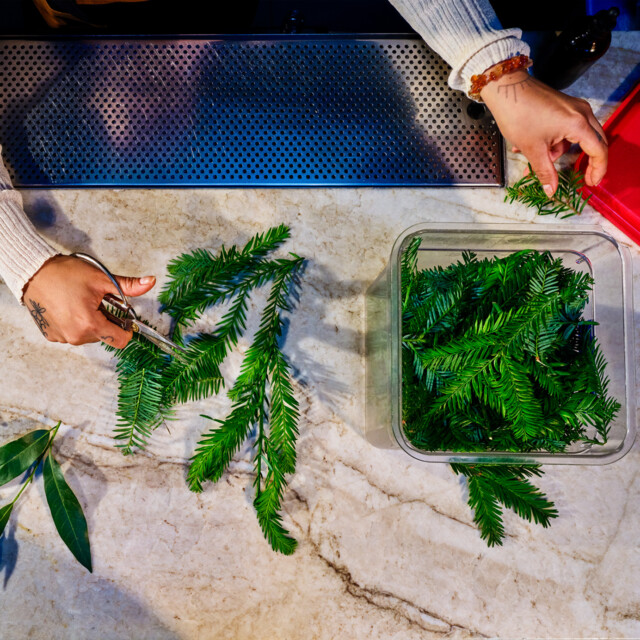After a year penning this column, it’s clear to me that we’ve entered a new golden age of cocktails. Good technique and advanced technology are approaching ubiquity — more and more bars are adopting centrifuges and rotovaps, the line continues to blur between chef and bartender, and historic texts continue to be mined for use in a modern context. While the column’s focus has primarily been New York City, where I’m based, these trends are proving true around the country and around the world.
San Francisco bar True Laurel taps into all of the aforementioned bells and whistles. While the menu reads unassumingly, it’s riddled with prep-heavy technical work. Clarification, infusion, carbonation, and batching for speed of service are all within the purview of bartender and prep lead Tone Arasa, who was kind enough to let me in for a peek behind the curtain on a chilly Bay Area morning. As the bar got set up for brunch service, Tone talked me through the ways in which one of their drinks makes the program at True Laurel unique.
Ninos Peardidos is a fully batched and carbonated cocktail with aged rum, pasilla chili liqueur, rooibos tea, and clarified pear and citrus juices. Obviously, the drink is technically complex (and absolutely delicious!), but the real magic lies in the sourcing of ingredients. “We have so much privilege and bounty just being in California,” Tone explains. It means that the bar’s access to farms and markets is top notch year-round, and they can simply call a farmer or visit them at the market and have world-beating produce for the bar. Another upshot: True Laurel can take on bruised or blemished fruits from farmers that would have otherwise been unable to sell them; perfect skin doesn’t affect the flavor of a cocktail, so the team is happy to be an outlet for these delicious, if irregular-looking products.
Sourcing these high-quality raw ingredients rather than using commercial juices and purees makes for more complex and terroir-driven cocktails for guests. But more importantly, it integrates the bar into a community of farmers and producers, and encourages sustainable farming practices. While bars like Kimball House in Decatur, Ga., and Kingfisher in Durham, N.C., have a similar focus on farms and farmers, the practice hasn’t made the jump to mainstream in the broader cocktail community. A devotion to seasonality and close relationships with producers is still rare and special.
Wild Ingredients and Building Community
In addition to sourcing phenomenal local produce, True Laurel leans heavily on foraging the natural bounty of Northern California. While the bar is located in a decidedly urban setting in San Francisco’s Mission District, the unique temperate coastal biome of the Bay Area means that wild and delicious botanicals are abundant everywhere — if you know where to look.
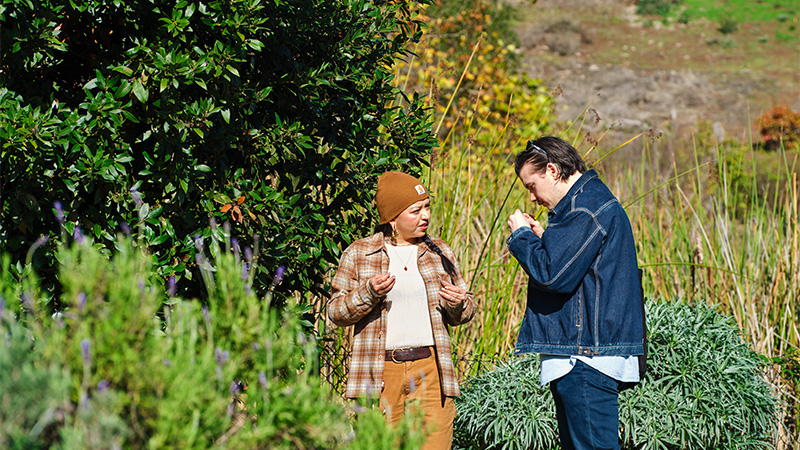
Foraging has been a staple of True Laurel’s menu development since the bar opened in 2017. In advance of my visit, I connected with partner and beverage director Nicolas Torres to learn about why foraging is important to his team and how he got into the practice. To my surprise, his initial forays were not for a bar or restaurant. “I was working in the nonprofit sector [in the early 2000s] with environmental justice and native habitat restoration as the focus,” he explains. “I got to work alongside some of the city’s top botanists, horticulturists, and activists. I learned about the local flora, its historical use, and I learned about the invasive flora as well.”
This backbone of knowledge found a beverage application when Nicolas developed the cocktail program for two-Michelin-starred Lazy Bear, a dining experience that began as a dinner party in chef David Barzelay’s apartment but quickly expanded into one of San Francisco’s most creative restaurants. The kitchen team used foraged ingredients like nasturtium, sorrel, and seaweed in elevated preparations, and Barzelay encouraged Nicolas to do the same in his drinks. Locality, seasonality, and foraging became inexorably intertwined with culinary excellence and sustainability. When Nicolas and chef David opened True Laurel together in 2017, the bar became a platform to synthesize everything he’d learned in a long and winding career both in and out of hospitality.
“We can do lacto fermentations, plus more tinctures and infusions — stuff that takes a tremendous amount of time and patience.”
While visiting True Laurel, and as a follow-up to the Ninos Peardidos cocktail, Tone made me two drinks that showcase foraged ingredients and are perennial menu staples at the bar. The In the Pines, Under the Palms is a spin on a Martinez, with coconut-fat-washed rye whiskey and gin married with vermouth, Maraschino, and arak. The finished cocktail is individually bottled with a juicy, aromatic young redwood sprig. The liquid is left to macerate on the sprig until its flavor profile mimics taking a walk through one of the redwood groves in the Presidio.
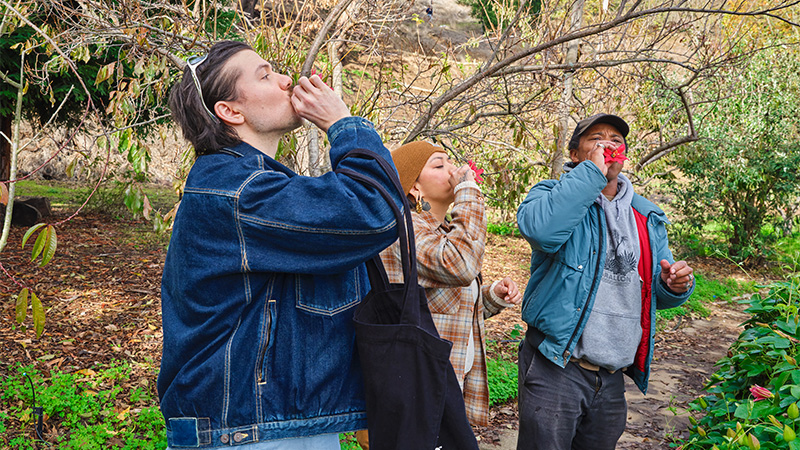
Meanwhile, the Laurel Martini combines gin with a slew of vermouths, a foraged bay laurel tincture, and Meyer lemon oil. “California Bay Laurel,” Nicolas explains, “is very different from sweet bay laurel — more eucalyptus-like.” I consider myself a full-time Martini drinker, and this one is a revelation: bright, crisp, with a long finish of juniper and eucalyptus intertwined. I grew up in the Bay Area and have never felt as connected to the flora of the region as when I drank these cocktails.
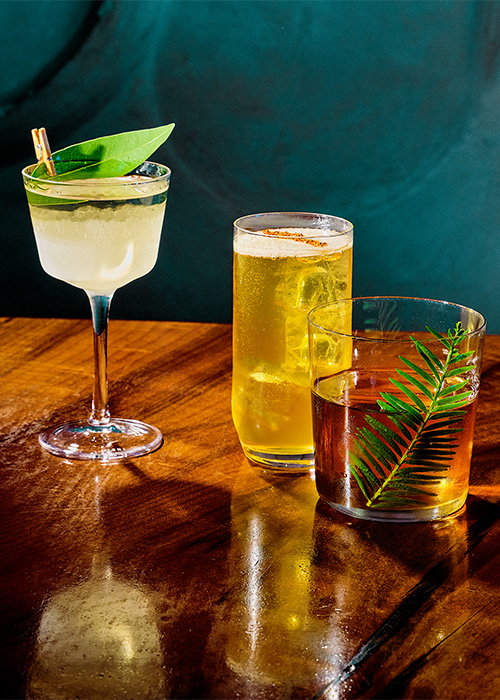
For Tone, these two drinks are only the beginning. The bar has just taken on an additional lab space for R&D and storage, a tremendous luxury in a city like San Francisco. “We can do lacto fermentations, plus more tinctures and infusions — stuff that takes a tremendous amount of time and patience,” they explain. In addition to laurel and redwood sprigs, the bar also uses — depending on the season — Islais Creek leaves, chaparral, yarrow, feijoa, cypress, nasturtium, and green pinecone. One can only imagine the natural bounty they will be able to showcase with the expansion.
Alemany Farm and the 280 Project
While Nicolas had hoped to be there in person to take us on a foraging outing, he was called away on bar business at the last minute. Instead, he kept his devotion to community at the forefront and connected me with Chris Renfro, a member of the Core Volunteer Advisory Board of Alemany Farm. The largest agricultural space within the city limits, many of the ingredients on the True Laurel menu grow wild there. After we finished up at the bar, Tone and I packed up and headed to the farm so that Chris could show us in-person where to find these plants.
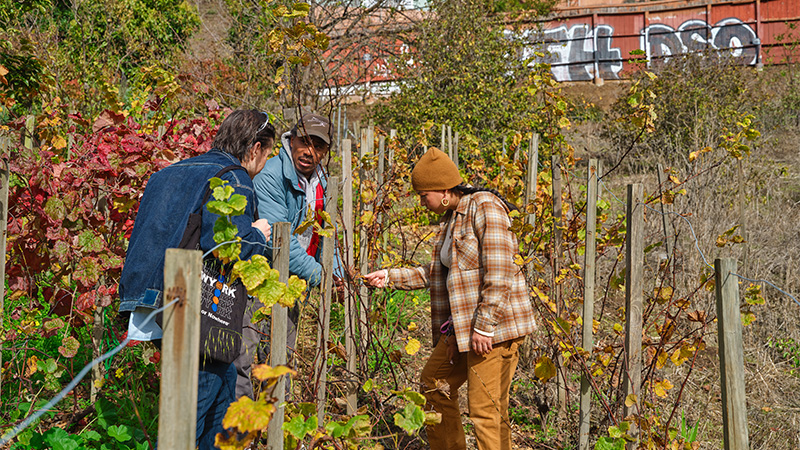
As an outsider approaching for the first time, Alemany appears to be a modest — though colossal for a city — plot of row crops like kale and radishes sandwiched between a steep hillside and the highway. Chris arrived and gave us the full tour, and I immediately realized how much this little plot was capable of.
As he shepherded us toward Bay Laurel and Islais Creek Cherry leaves (that smell remarkably like cherry cola and will eventually make their way into a True Laurel kumquat cola), Chris gave us an overview of the farm. “Alemany is 2.5 acres of garden and public park,” he told us. “Friends of Alemany Farms stewards the land, volunteers come, they help. There’s a group of apprentices, a lot of BIPOC, LGBTQ community members that come and help out. All the food and everything grown here is completely free to the community.”
The time I spent at Alemany demonstrated what sets True Laurel apart. Of course, the drinks are phenomenal, but the real story is the work they do to be in and of their community, showcasing local flavors and people who are making life more fair, equitable, and delicious for their neighbors.
Every year, Alemany grows and gives away 15 tons of produce to surrounding residents. The agricultural work and land stewardship they practice mean that indigenous plants that also populate the plot like laurel and redwood are lush, healthy, and insanely fragrant. The agricultural work feeds nature and the community and makes for more delicious cocktails.
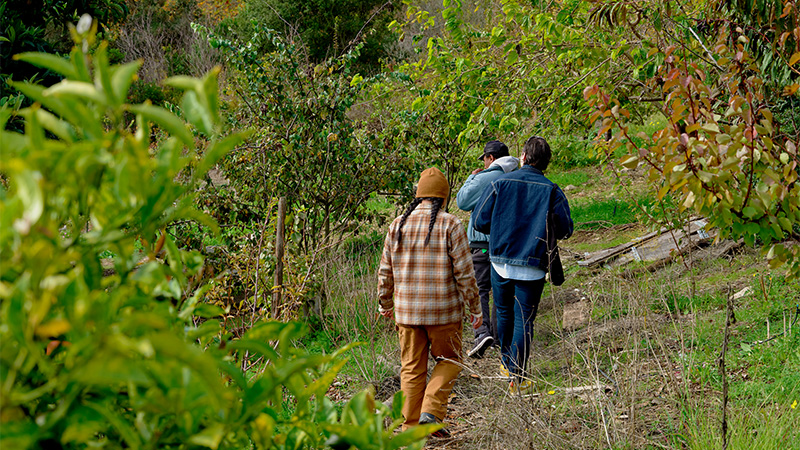
As we walked through the grounds it became clear just how teeming with life and delicious plants this farm is; rose geranium here, a pineapple guava tree there, persimmons, passionflower, a garter snake slithering, rosemary, Mexican marigold, a coyote den in the distance — it just went on and on. We made our way up the precarious hillside where Chris planted four rows of both wine and table grapes. The vines are an educational tool for his organization the 280 Project, which he founded in 2019 with his partner Jannea Tschirch.
“The 280 Project is a non-profit aimed to get LGBTQ, BIPOC people into the wine industry through a paid apprenticeship that we hold,” Chris explained. “For six months of the growing season, we go to different wineries, different vineyards, and get people, I wouldn’t say just educated, but experienced in the industry.”
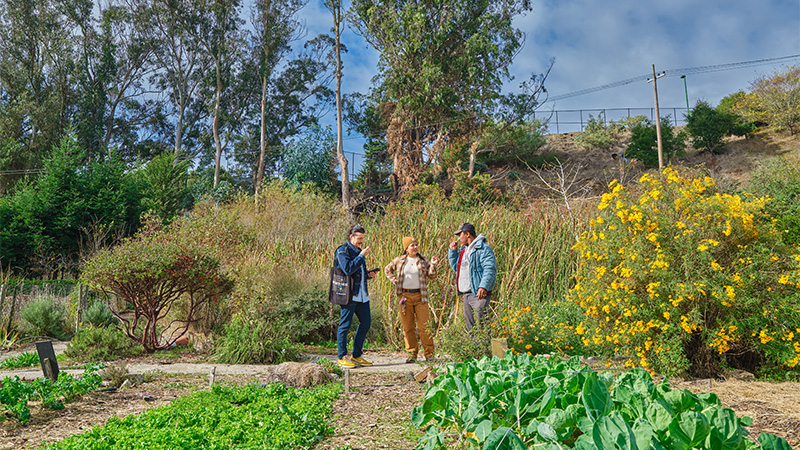
Chris teaches them the basics of viticulture and regenerative agriculture at Alemany so they can have a leg up when they get to professional vineyards. The table grapes are there to get community members of all ages excited about farming with something that’s delicious right off the vine. It was a remarkable afternoon, one that left me feeling hopeful and full. The time I spent at Alemany demonstrated what sets True Laurel apart. Of course, the drinks are phenomenal, but the real story is the work they do to be in and of their community, showcasing local flavors and people who are making life more fair, equitable, and delicious for their neighbors.
How to Get Started Foraging
The beautiful thing about foraging is that it’s completely free and everyone can take advantage. It just takes a little knowledge to get out there. Chris gave me some tips to get started, and as you might have guessed they all involve getting active with community members and community history. He recommends consulting local books and field guides on local plants and agriculture — books like Pam Pierce’s “Golden Gate Gardening” — and looking online for local foraging groups. Check with local libraries as well; San Francisco’s Protrero Hill and Portola branches of the public library have free seed libraries for members (and wouldn’t you know it, the NYPL does as well!) who are ready to try their hand at agriculture, as well as all the field guides you need to start harvesting local botanicals.
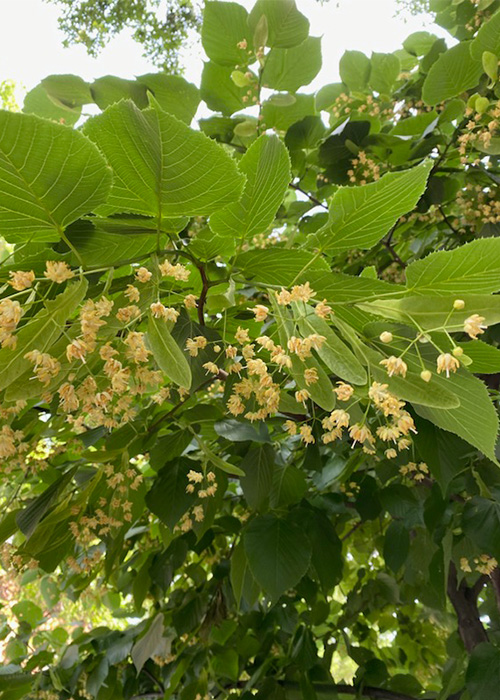
For the New Yorkers, I’ve got the lowest lift possible intro to foraging. At both Booker and Dax and Existing Conditions, we would showcase local foraging in early to mid-summer when the linden trees would bloom. The American linden is native to New York, can be found wild in Central Park, and is planted in abundance on streets throughout Manhattan and Brooklyn. They bloom between June and July depending on the year and the tree; their tiny buds exploding into sweet-smelling flowers. All you have to do is pluck the flowers from the tree and wash them and you’ve got a phenomenal hand-harvested cocktail ingredient — even if it came from just down the block. At the bars, we would nitro muddle the blossoms (freeze them in liquid nitrogen, then muddle them into a fine powder) before building a classic gin sour on top of them. But for those of you without access to liquid nitrogen, traditional muddling will do just fine.
Linden Sour
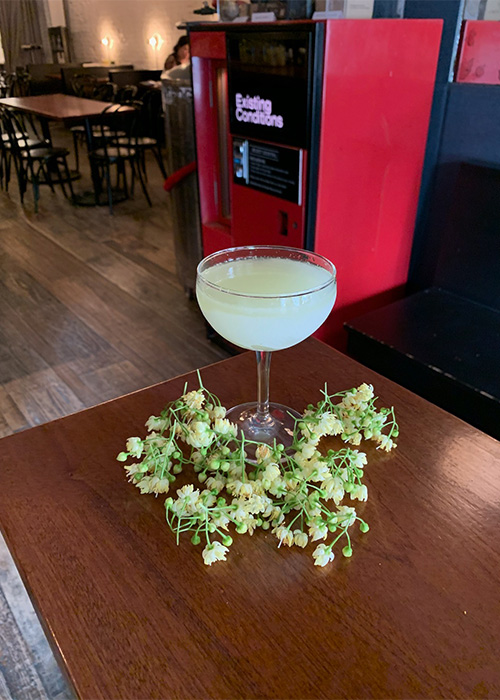
Ingredients
- 2 ounces Plymouth gin
- ½ ounce fresh lemon juice
- ½ ounce simple syrup
- 5 drops 20 percent saline solution (20 grams salt dissolved in 80 grams water)
- 8-10 linden blossoms
Directions
- Add linden blossoms to a shaker tin.
- Lightly press with a muddler to release their aroma; don’t get too aggressive or the drink will be bitter.
- Add the rest of the ingredients to the tin with the blossoms.
- Fill with ice and shake.
- Fine-strain into a chilled coupe to remove any flower bits.
This story is a part of VP Pro, our free platform and newsletter for drinks industry professionals, covering wine, beer, liquor, and beyond. Sign up for VP Pro now!
